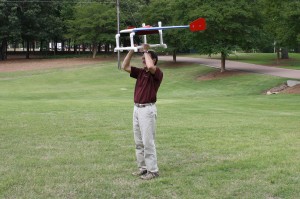Applied Acoustics
 The Applied Acoustics group studies what some would call “traditional” acoustics research: the propagation of audible sound in the atmosphere. Because the atmosphere is a striated and dynamic medium, sound waves do not travel in a simple straight line – they may bounce off boundary layers and reflect back down to the earth’s surface far from the source or be diverted by wind patterns. This group studies methods for locating sources of sound in a variety of scenarios: both source and sensors stationary or mobile sensors and stationary targets. Understanding the propagation path is crucial, but also important are methods for reducing wind noise so these systems are more sensitive to the signals of interest. This is accomplished using a sensor array and signal processing of the raw acoustic data. The Applied Acoustics group also has an interest in designing portable air born acoustic arrays.
The Applied Acoustics group studies what some would call “traditional” acoustics research: the propagation of audible sound in the atmosphere. Because the atmosphere is a striated and dynamic medium, sound waves do not travel in a simple straight line – they may bounce off boundary layers and reflect back down to the earth’s surface far from the source or be diverted by wind patterns. This group studies methods for locating sources of sound in a variety of scenarios: both source and sensors stationary or mobile sensors and stationary targets. Understanding the propagation path is crucial, but also important are methods for reducing wind noise so these systems are more sensitive to the signals of interest. This is accomplished using a sensor array and signal processing of the raw acoustic data. The Applied Acoustics group also has an interest in designing portable air born acoustic arrays.
- For the past decade, applied acoustics has been one of the most significant and productive research areas at NCPA. Early success led, in 2002, to the formation of the Acoustic Center of Excellence (ACOE), which is a partnership between NCPA, the Army at Picatinny Arsenal (ARDEC), and private industry. The role of NCPA in this partnership is to provide the ACOE with the basic research required to keep the Center at the leading edge of technology and to provide for education of personnel to develop the technologies of tomorrow. The role of private industry is to transition that research into acoustic devices that may prove of value to the Army. The role of ARDEC includes both transitioning of research and field testing and evaluation of acoustic devices.
- In the past year, ACOE has provided support to the Army Test and Evaluation Command (ATEC) with Soldier Wearable Acoustic Targeting System (SWATS) II testing at Aberdeen Proving Ground to obtain Safety Certification. This allowed for a Limited User Assessment (LUA) using 1000 SWATS units delivered to the Rapid Equipping Force for theater use.
- The Center provided and supported Ears and SWATS systems delivery to the Navy (SEALs) for LUA.
- The Center is supporting PM Robotics and Unmanned Sensors and PM Joint Tactical Radio System (JTRS) for integrating Current Force-Unattended Ground Sensor (UGS) and JTRS Small Form Factor – a radio integration for demo at 2009 C4ISR OTM and future integration into a FCS UGS system.
- ACOE will put together the final technical report for the VM-GSD system evaluation.
- Coyote, a border security system, will be deployed to collaborate with the Picatinny Blast Monitoring effort. Though Coyote was designed for perimeter/border surveillance, it lends itself well to blast monitoring because it is small, low cost, and highly scalable, as well as having a high power backend database.
- Major accomplishments include the continued transitioning of improvements to acoustic signal processing technologies that were originally developed at NCPA to industry partners, Miltec Research & Technology and Radiance Technologies. These signal processing techniques are used in acoustic battlefield devices that have been field tested by Army end-users and, in some cases, tested in theater.